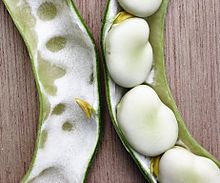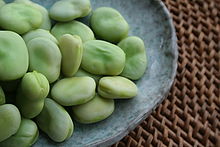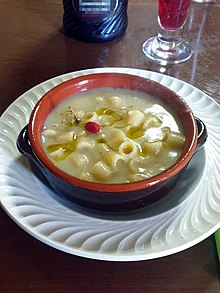
Minestrone is a thick soup of Italian origin made with meats, vegetables, and pasta. Ingredients include beans, onions, celery, carrots, leaf vegetables, stock, parmesan cheese and tomatoes.
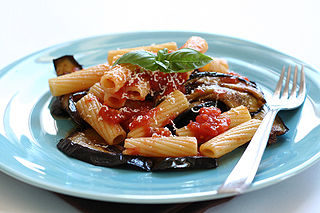
Sicilian cuisine is the style of cooking on the island of Sicily. It shows traces of all cultures that have existed on the island of Sicily over the last two millennia. Although its cuisine has much in common with Italian cuisine, Sicilian food also has Greek, Spanish, French, Jewish, and Arab influences.

Saint Joseph's Day, also called the Feast of Saint Joseph or the Solemnity of Saint Joseph, is in Western Christianity the principal feast day of Saint Joseph, husband of the Virgin Mary and legal father of Jesus Christ, celebrated on 19 March. It has the rank of a solemnity in the Catholic Church. It is a feast or commemoration in the provinces of the Anglican Communion, and a feast or festival in the Lutheran Church. Saint Joseph's Day is the Patronal Feast day for Poland as well as for Canada, persons named Joseph, Josephine, etc., for religious institutes, schools and parishes bearing his name, and for carpenters. It is also Father's Day in some Catholic countries, mainly Spain, Portugal, and Italy. It is not a holy day of obligation for Catholics in the United States.

Vicia faba, commonly known as the broad bean, fava bean, or faba bean, is a species of vetch, a flowering plant in the pea and bean family Fabaceae. It is widely cultivated as a crop for human consumption, and also as a cover crop. Varieties with smaller, harder seeds that are fed to horses or other animals are called field bean, tic bean or tick bean. Horse bean, Vicia faba var. equinaPers., is a variety recognized as an accepted name. This legume is very common in Southern European, Northern European, East Asian, Latin American and North African cuisines.
Cuccìa is a traditional, primarily Sicilian dish containing boiled wheatberries and sugar, which is eaten on December 13, the feast day of Saint Lucy, the patron saint of Syracuse. The dish is consumed in Sicily and in isolated pockets of southern Italy, as well as their communities abroad. It commemorates the relief from a food shortage in Sicily and the unexpected arrival of a cargo of wheat, which tradition says arrived in the port of Palermo on Saint Lucy's Feast in 1646. According to custom, bread should not be eaten on December 13; cuccìa should be the only source of wheat, and the primary source of nourishment for the day.
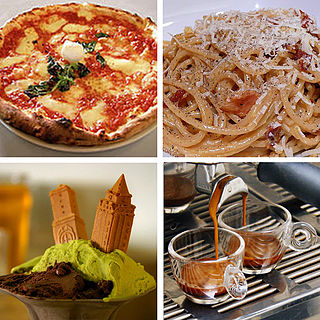
Italian cuisine is a Mediterranean cuisine consisting of the ingredients, recipes and cooking techniques developed in Italy since Roman times and later spread around the world together with waves of Italian diaspora. Some of these foods were imported from other cultures. Significant changes occurred with the colonization of the Americas and the introduction of potatoes, tomatoes, capsicums, maize and sugar beet—the latter introduced in quantity in the 18th century. It is one of the best-known and most appreciated gastronomies worldwide.

Sicilian Americans are Italian Americans who are fully or partially of Sicilian descent, whose ancestors were Sicilians who emigrated to United States during the Italian diaspora, or Sicilian-born people in U.S. They are a large ethnic group in the United States.

Joseph was a 1st-century Jewish man of Nazareth who, according to the canonical Gospels, was married to Mary, the mother of Jesus, and was the legal father of Jesus.

Ditalini, also referred to as tubettini, is a type of pasta that is shaped like small tubes. It has been described as "thimble-sized" and as "very short macaroni". In some areas it is also called "salad macaroni". During the industrial age in Apulia, Italy, increased development of ditali and other short-cut kinds of pasta occurred. In contemporary times, it is a mass-produced pasta. It is used in several dishes and is commonly used throughout Sicily.

Pasta con le sarde is a Sicilian pasta dish with sardines and anchovies. It is recognized as a traditional Italian food product in the prodotto agroalimentare tradizionale (PAT) scheme of the Italian government. It is most associated with Sicily's capital Palermo, but it can be found all over the island.
Sciusceddu is a soup in Sicilian cuisine prepared using meatballs and broken eggs as primary ingredients, served as a traditional Easter dish in Messina, Sicily. Additional ingredients used include broth, caciocavallo and ricotta cheeses, parsley, salt and pepper. It can be prepared in a similar style to egg drop soup.

Apulian cuisine consists of the cooking traditions and practices of the region of Apulia in Italy. Starting from the Middle Ages the permanent residence of the nobility in the region gradually declined, which caused the disappearance of their noble cuisine over time. As the common people suffered from poverty, their culinary tradition adapted to use cheap and simple foods. Bread, vegetables and pasta have the leading role in the cuisine. Fruits, fish and wine are consumed frequently as well, but meat plays a minor role. The food of Apulia is known as a prime example of cucina povera or 'cuisine of the poor', characterizing its simplicity rather than its quality. Moreover, the simple dishes allow the quality of their local and seasonal ingredients to take center stage.
U cumbitu 'i San Giuseppi, also known as u mmitu 'e San Giuseppe, or u banquettu around Catanzaro, is a custom in the Calabria region, southern Italy, in which lagane e ceci, a pasta dish containing chickpeas, is shared among families and neighbours on Saint Joseph's Day.
